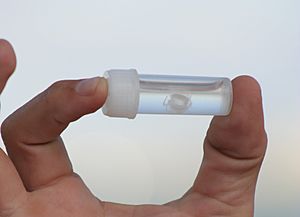Irukandji jellyfish facts for kids
Irukandji jellyfish are tiny, super venomous jellyfish found in the waters around Australia. They are a type of box jellyfish. Even though they are only about the size of a sugar cube (1 cubic centimeter), they are one of the smallest and most dangerous jellyfish in the world!
These amazing creatures can shoot their stingers into people. This causes a group of symptoms called Irukandji syndrome. There are about 16 different types of Irukandji jellyfish known to scientists. They mostly live in the northern parts of Australia. Scientists have noticed that these jellyfish are slowly moving further south along Australia's east coast. They think this might be happening because of climate change.
Contents
What Happens When an Irukandji Stings?
Most jellyfish only have stingers on their long arms, called tentacles. But Irukandji jellyfish are special! They also have stingers on their main body, which is called the bell. Scientists are still trying to figure out why they have stingers there. One idea is that it helps them catch small fish, which are their food.
Irukandji jellyfish can shoot their stingers and inject a very powerful venom. This venom is incredibly strong. It is 100 times more powerful than a cobra's venom and 1,000 times stronger than a tarantula's! Their stings are so serious that they can cause bleeding in the brain. About 50 to 100 people go to the hospital each year because of an Irukandji sting.
Irukandji Syndrome: What It Feels Like
The sting itself might only feel a little annoying at first. But the serious symptoms of Irukandji syndrome usually start about 5 to 120 minutes later, often around 30 minutes. Even a tiny bit of venom can cause a lot of problems.
People who are stung might feel:
- Very bad muscle cramps in their arms and legs
- Strong pain in their back and kidneys
- A burning feeling on their skin and face
- Headaches
- Feeling sick to their stomach (nausea)
- Feeling restless and unable to sit still
- Sweating a lot
- Throwing up (vomiting)
- Their heart beating very fast
- High blood pressure
- A scary feeling that something bad is about to happen
These symptoms can last for hours or even weeks. Most people who get Irukandji syndrome need to go to the hospital for help. It was once thought that vinegar helped, but recent research shows it actually makes the venom release more.
How Doctors Help with Irukandji Stings
Doctors treat the symptoms of an Irukandji sting. They might give medicines like antihistamines to help with swelling. They also use medicines to control high blood pressure. For the severe pain, they often give strong pain medicines like morphine or fentanyl. Sometimes, a medicine called Magnesium sulfate is used to help with pain and high blood pressure, but it doesn't always work for everyone.
Learning More About Irukandji Jellyfish
Scientists don't know much about the full life cycle of Irukandji jellyfish or exactly how their venom works. This is because they are so small and delicate. They need very special care to be studied.
The Irukandji jellyfish is related to the larger box jellyfish called Chironex Fleckeri. The Irukandji was first officially identified in 1964 by a doctor named Jack Barnes in Cairns, Australia. The scientific name for the Irukandji is named after him!
Dr. Barnes was sure that a small jellyfish was causing people to get sick in the sea. He bravely spent six days lying on the ocean floor with diving gear until he finally found one. To prove it was the cause, he even tested its sting on himself, his son, and a lifeguard! They all had to go to the hospital, but his brave actions helped everyone understand this dangerous creature.
Because Irukandji jellyfish are so small and fragile, they can't be kept in a regular aquarium. The first Irukandji jellyfish to be successfully kept and born in captivity happened in Townsville, Queensland.
Images for kids
-
A picture showing the size of an Irukandji jellyfish and its tentacles. Below the jelly's main body (bell) are two young forms of the species.


